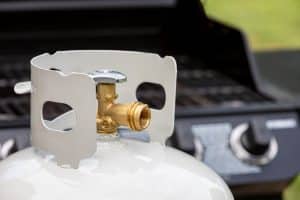Home > Energy Plans > Types Of Gas
Types Of Gas
Find out about the different types of gas available for domestic use in Australia here with Savvy.
Author
Savvy Editorial TeamFact checked

Many Aussie households rely on gas to heat their water, cook their food and keep warm in winter. In fact, gas is a major energy source for over 70% of Australian homes. But have you ever wondered about the different types of gas available? Is the gas you cook with on the stove the same as the gas in your BBQ bottle or in a gas-powered car? Find your answers right here!
What different types of gas are available in Australia?
There’s several different types of gas widely available in Australia, including natural gas, LPG, butane gas and biogas. Let's explore these different types of gas in detail:
Natural gas
Natural gas is a widely used fuel source for many homes and businesses across Australia. Primarily composed of methane gas, it is a non-renewable fossil fuel which is extracted from underground gas reserves. The advantage of natural gas is its efficiency and clean-burning nature. It is delivered through pipelines directly to households where it is commonly used for heating water, cooking and keeping us warm in winter.
In addition to domestic use, Australia is the seventh-largest exporter of natural gas in the world. Its export value was estimated at over $92 billion in 2022/2023. However, before natural gas can be exported, it has to be cooled down to minus 162 degrees celsius, when it turns into a liquid known as LNG, liquefied natural gas. This liquid is loaded into tankers and exported all over the world.
LPG
LPG (Liquefied Petroleum Gas) is the liquid form of a mixture of propane and butane gas, which is produced as a by-product of the oil refining process. It is pressurised to keep it in liquid form, and then supplied under pressure in gas cylinders or tanks, often in situations where natural gas pipelines are not available. Most Aussies know LPG from their BBQ gas cylinders, but it is also used to power gas-fuelled cars. It also has many commercial uses, such as powering kilns, drying ovens and steam boilers.
Butane
Butane is a specific type of LPG that is used in portable devices such as small camping stoves, camping lights and lighters. It has a lower boiling point compared to propane gas, which makes it suitable for devices requiring easy vaporisation. However, this also means that in very cold situations, butane gas stoves may not work as well, which is why a small proportion of propane gas is often added to butane gas cannisters. In addition, because of its low boiling point, it’s very important not to leave butane gas lighters or cannisters in direct sunlight or in hot cars in summer. Overheating a butane gas cannister or lighter risks an explosion.
Biogas
Biogas is also called ‘green gas’ or ‘biomethane’ because it is gas which is captured from decomposing organic waste material. It is called green gas because it is a ‘renewable’ resource, meaning that it can be collected and bottled as long as there is decaying organic matter available. However, at a molecular level it is still methane gas, which is the same as natural gas extracted from underground. For this reason, it can safely be mixed with conventional methane natural gas. Any appliances which usually burn natural gas can also burn biogas.
Renewable hydrogen
Hydrogen is the most abundant element in the universe. In its normal state, hydrogen is a colourless and odourless gas, just like other flammable fuels such as natural gas, methane. For this reason, it can be used in many of the same ways as natural gas.
However, we can produce renewable hydrogen by a process known as electrolysis. This involves using electricity to split water up into its two basic elements, hydrogen and oxygen. The electrolysis process separates the atoms of hydrogen and oxygen. They are then reformed back into water vapour when you burn the hydrogen, releasing energy as heat.
One crucial advantage of hydrogen is that when it is burned, it only produces water vapor and heat. This makes hydrogen a clean and environmentally-friendly energy source with the potential to reduce greenhouse gas emissions, which are a major contributor to global warming.
What’s the future of gas in Australia?
In the past two years, renewable gas (hydrogen) has just started to be introduced for domestic use in Australia. For example, in South Australia, the first renewable hydrogen gas project supplying domestic customers was opened at Tonsley Park in May 2021. Similarly, the Hydrogen Park in Gladstone started supplying hydrogen to the Gladstone gas distribution network in Queensland in late 2022.
Australian Gas Networks aims to supply 10% renewable gas to Australians by 2030, and 100% renewable gas by 2040. This is in line with the Federal Government’s Climate Change Act of 2022, which aims for Australia to produce net zero emissions of greenhouse gas by 2050.
Helpful energy guides
Compare energy plans
Disclaimer:
Savvy is partnered with Econnex Comparison (CIMET Sales Pty Ltd, ABN 72 620 395 726) to provide readers with a variety of energy plans to compare. We do not compare all retailers in the market, or all plans offered by all retailers. Savvy earns a commission from Econnex each time a customer buys an energy plan via our website. We don’t arrange for products to be purchased directly, as all purchases are conducted via Econnex.
Any advice presented above is general in nature and doesn’t consider your personal or business objectives, needs or finances. It’s always important to consider whether advice is suitable for you before purchasing an energy plan. For further information on the variety of energy plans compared by Econnex, or how their business works, you can visit their website.










